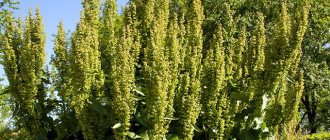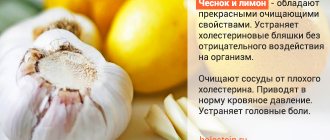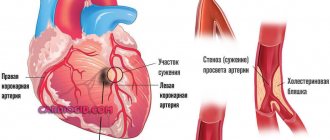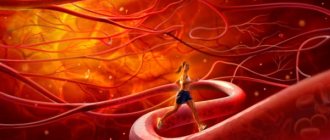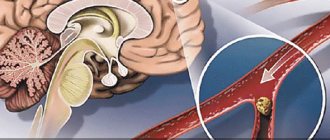We all regularly hear from doctors that blood cholesterol levels should be maintained at a constant and fairly low level. As a result, this substance seems to many people far from medicine to be almost a source of evil, the presence of which in the body is associated exclusively with negative consequences. In fact, this is not true at all.
First of all, let us recall that cholesterol is an organic compound that not only enters the human body with food, but is also synthesized by our liver. It is necessary to prevent premature aging, and also helps the body absorb fats and fat-soluble vitamins. According to doctors, normal blood cholesterol levels range from 3.6 to 5.2 mmol/l. Moreover, the upper limit may vary depending on the gender of the person and the age category to which he belongs.
One of the natural properties of cholesterol is the following: during blood circulation, it “sticks together”, as a result of which its accumulations, the so-called atherosclerotic plaques, appear on the walls of blood vessels. They interfere with normal blood circulation, resulting in oxygen starvation of the tissues of the brain, heart and other organs. Also, blocking of blood vessels with atherosclerotic plaques is fraught with strokes and heart attacks. Therefore, doctors insist that blood cholesterol levels should be regularly monitored.
What to do if the study shows an increase in cholesterol levels? In addition to medications, proper nutrition will help normalize the indicator. Nutritionists are well aware that a number of foods have “anticholesterol” properties—in other words, they help break down excess cholesterol.
Nuts
All types of nuts are an excellent source of healthy saturated fats. Essential fatty acids omega-3 and omega-6 prevent the occurrence of atherosclerotic changes in blood vessels. Almonds and cashews contain magnesium, which increases the elasticity of blood vessels and helps dissolve plaques. In addition, most nuts contain flavonoid pigments - special plant compounds that help strengthen arterial walls. Peanuts, tree nuts and almonds help avoid fatty liver disease, as a result of which its function is normalized.
Please note that if cholesterol increases, nuts should be eaten unprocessed, since high temperatures destroy the beneficial substances in them.
Prevention of excess cholesterol
For modern people, it is important to know that there is no specific prevention for reducing this substance. Therefore it is necessary:
- change your lifestyle;
- give up bad habits (smoking, reducing alcohol consumption);
- eat rationally. Among the diets that doctors prescribe, the Mediterranean diet should be noted. It includes eating plenty of greens, vegetables, fruits, legumes, lean turkey and chicken, and eating lean fish;
- engage in physical exercise. Nordic walking, swimming or walking for more than 2 hours a day helps improve your health.
Exercise helps in lowering cholesterol.
This is what has a positive effect on health and reduces the risk of atherosclerosis, and as a result, such severe socially significant diseases as myocardial infarction, acute cerebrovascular accident and other vascular accidents.
It is not for nothing that it is said that doctors treat diseases, but you need to achieve health yourself.
Flax seed
Flax seeds and oil from them have long been used to improve the health of the body. First of all, flax seeds contain fiber, which helps retain fat and cholesterol in the digestive system, as a result of which the content of the latter in the blood is significantly reduced. In addition, vitamins B3 have a positive effect on fat metabolism, thereby reducing the content of low-density lipoproteins in the blood, which, when oxidized, can form atherosclerotic plaques. Finally, the selenium found in flax seeds helps increase good cholesterol and reduce bad cholesterol. You can use flax seed as an ingredient in salads, in the preparation of porridges and breadings.
Recipes
Fish baked with vegetables
0.5 kg pike perch fillet, 2-3 tomatoes, zucchini, eggplant, lettuce pepper, onion, 2 cloves of garlic, 2 tbsp. spoons of vegetable oil.
Roughly chop the onion, garlic, zucchini and eggplant. Mix the vegetables, season with pepper, vegetable oil, Provençal herbs and marinate for 30 minutes. Also grease the fish fillet with oil and season with herbs. Place the prepared vegetables on foil, place the fish fillet on top and cover with small tomatoes. Bake for 15-20 minutes.
Fish baked with vegetables and cheese
Hake fillet 500 g, carrots, onions, tomatoes, low-fat cheese 50 g, vegetable oil.
Cut the fillet into portions, marinate in spices and allspice. In a frying pan, simmer finely chopped onion and grated carrots, adding a little vegetable oil. Place the hake fillet in a small dish, cover with a layer of stewed vegetables and slices of chopped tomato. Bake for 20 minutes, sprinkle with grated cheese at the end and place in the oven for another 3 minutes.
Baked chicken breast
Chicken fillet 300 g, fresh vegetables and herbs to taste, olive oil 1 tbsp, milk 0.25 cup, garlic.
Lightly beat the chicken fillet and marinate in olive oil with garlic, rosemary and milk for half an hour. Place in pan and bake. Season the finished dish with salt and serve with any fresh vegetables.
Chicken fillet with green beans
One chicken fillet, 300 g beans, pepper, spices, olive oil, salt.
Cut the chicken fillet into cubes and simmer until half cooked in a saucepan with a little water. Add frozen green beans, spices to taste and simmer under the lid until the chicken is completely cooked. Before serving, add herbs, olive oil and a little salt. Serve warm.
Why is an elevated level dangerous?
With high “bad” cholesterol (LDL and VLDL), due to a long-term defect in fat metabolism, serious cardiovascular complications may develop:
- Cardiac ischemia. It is caused by damage to the coronary arteries by atherosclerotic plaques, which gradually reduce the flow of blood and nutrients to the heart muscle. When the blockage of the vessel is significant, angina pectoris is formed - chest pain with any physical activity. When the artery is completely blocked, myocardial infarction develops - necrosis of the heart muscle and disruption of systemic hemodynamics.
- Stroke. It can be ischemic (obstruction of the lumen of a cerebral artery by a migrating thrombus, followed by necrosis of the brain substance) or hemorrhagic (the main cause is atherosclerotic damage to the vessels of the central parts of the nervous system with increased permeability and fragility, when any stress factor (hypertensive crisis, blood clot) can lead to rupture and melting of brain matter).
- Chronic cerebral ischemia. It is a narrowing of the extracranial arteries with decreased oxygenation of the brain. The severity of cognitive functions (memory, attention, thinking) gradually decreases, and atrophic and dystrophic changes form.
- Atherosclerosis of the vessels of the lower extremities. They lead to various gait disturbances (“intermittent claudication”) and necrosis of the distal parts of the legs (fingers, feet).
Against the background of atherosclerosis, blood viscosity increases significantly, which aggravates the course of other somatic pathologies, and the activity of other components of the metabolic syndrome (arterial hypertension, obesity, type II diabetes mellitus, gout) sharply increases.
Expert commentary
Kardash Anton Borisovich
Therapist, cardiologist. Doctor of the highest category.
Treatment of atherosclerosis must be comprehensive. For prevention or in the initial stages, the use of folk remedies in combination with normalization of diet and lifestyle changes is allowed. In severe cases, medication support is required.
Medicinal plants
How to remove cholesterol from the body at home using medicinal plants? The most effective are decoctions and infusions of herbs. They are usually prepared in a ratio of 1:10 - 10 parts of water for one part of the ingredients.
A decoction is made from the roots, bark, and fruits. The ingredients are poured with cold water, simmered over low heat for about 30 minutes, covered with a lid, and allowed to brew for another 10-20 minutes. Then filter, carefully squeezing out the remainder.
Infusions are prepared from leaves, flowers, and stems. Pour boiling water over the ingredients and leave for 1-2 hours, tightly covering the container with a lid. Then filter and squeeze out the remainder. Store in the refrigerator for no more than 3 days.
The following types of herbs help lower cholesterol:
The roots of Dioscorea Caucasica contain many saponins, which destroy low-density particles. The active substances of the plant restore blood vessels, cleanse them of cholesterol plaques, and improve heart function. 1 tsp. roots ground into powder, mixed with 1 tsp. honey, taken three times a day after meals. Duration of treatment is 1 month. Contraindications: pregnancy, bradycardia. Golden mustache or callisia fragrant increases HDL levels and reduces LDL concentrations. For treatment, an infusion of the leaves of the plant is used. They drink it 1 tbsp. l. three times a day 30 minutes before meals, 1.5-2 months. Contraindications – liver disease, kidney disease, lactation, children, adolescents under 14 years of age. Licorice roots help with high cholesterol, diabetes, and hypotension. A decoction of raw materials is taken 4 times a day after meals for 3-4 weeks. After a two-week break, the course can be repeated. Contraindications – high blood pressure, pregnancy, pathologies of the adrenal glands, liver, blood diseases. Consuming licorice root often causes severe headaches. If such a symptom appears, you need to reduce the dosage. The fruits of Sophora japonica help remove excess cholesterol, improve blood vessels, and slow down atherosclerosis. The most effective alcohol tincture. To prepare it, 50 g of raw materials (you can add the same amount of white mistletoe) are poured with 0.5 liters of alcohol. Infuse in a dark, warm place for 2 weeks. 1 tsp. The tinctures are diluted with water and drunk before breakfast. The course of therapy lasts 1 month. Contraindications: pregnancy, lactation, liver and kidney diseases. Hawthorn inflorescences help reduce cholesterol by 10% in 2-3 weeks. An infusion is prepared from dry raw materials, which is taken 2-4 times a day, 1 tbsp. l
Hawthorn infusion should be used with caution for stomach ulcers, heart rhythm disturbances, hypotension, and during pregnancy. Linden inflorescences. Dried flowers are made into powder
Take 1 tsp three times a day with water. Course duration is 1 month. Treatment with linden is contraindicated for bronchial asthma, diabetes, and renal failure. Dandelion root contains a lot of lecithin, which prevents the deposition of cholesterol plaques. The rhizome of the plant is dried, ground, and taken three times a day, 1 tsp. before meals, with water. The course lasts 3 months, then take a month break and repeat if necessary. It is not advisable to be treated with the plant for heartburn, stomach ulcers, and intestinal diseases. Alfalfa sowing. Juice from the leaves of the plant or sprouted seeds help quickly reduce cholesterol. To do this, take 2 tbsp three times a day. l. juice or 4 tbsp. l. sprouted plant seeds. Treatment lasts a month. Contraindications – autoimmune diseases, increased blood viscosity, stomach ulcers. St. John's wort and ginseng reduce the synthesis of fats by the liver and may well replace pharmaceutical drugs statins. An infusion of plants is drunk twice a day before breakfast and afternoon snack. Therapy lasts 3 weeks. Not recommended for use during pregnancy, lactation, hypertension.
To quickly reduce cholesterol, you can also use calendula flowers, jaundice, immortelle, elecampane, white cinquefoil, plantain seeds, and thistle. It is better to use them comprehensively, mixing 2-3 herbs in equal proportions.
Is it possible to drink alcohol?
This question worries many patients with high blood cholesterol, because they often receive offers to go on a visit, celebrate a significant event, etc. Is it possible to skip a glass of alcohol or should you refrain from even the minimum dose of strong drinks?
It all depends on two factors: what dose of the drink will be taken, and also what type of alcohol it is. Strong drinks have different effects on the body, including the harmful cholesterol present in the blood vessels:
- vodka - doctors do not note any beneficial effects for this drink; on the contrary, they consider it dangerous. Many manufacturers add to their products, instead of the required ethyl alcohol, a cheap substitute - methyl alcohol. As a result, even 30 gr. the poison consumed will be enough not only to not lower cholesterol, but also to lose life;
- Whiskey is a natural drink made from malt, rich in ellagic acid. It has a pronounced effect on bad cholesterol, being a good antioxidant. Fights harmful substances, removes toxins, but only with regular small amounts of whiskey consumed;
- cognac – approximately 30–50 grams of cognac per week will help lower cholesterol levels and improve vascular tone. Consumption of large doses reduces the effect and leads to the development of alcoholism;
- dry wine – reduces the level of harmful substances in the blood, gives tone to blood vessels, neutralizes the effect of free radicals.
When taking statins and other groups of drugs that a doctor may prescribe, drinking alcohol is contraindicated due to severe side effects on the liver. Therefore, before drinking even a glass of “healthy” dry wine, you need to make sure there are no contraindications.
Table of recommended and prohibited foods for high cholesterol
| Recommended | Limited | Forbidden |
| Fish and seafood | ||
|
Can be consumed no more than 2 times a week, boiled, in small portions of about 100 g. |
|
| Meat products | ||
They are introduced into the menu in portions of no more than 100 g, every other day. |
| |
| Oils, fats | ||
|
Add to prepared dishes. Norm 2 tbsp. l. in a day. |
|
| Dairy and fermented milk products | ||
Fat content from 0.5 to 5%. |
No more than 3 times a week. |
|
| Vegetables | ||
| Fresh and frozen vegetables, corn, beans, lentils. | Boiled potatoes no more than 3 times a week. |
|
| Fruits | ||
| Any fresh fruit. | It is recommended to consume dried fruits every other day. |
|
| Cereals | ||
|
|
|
| Bakery | ||
|
You can eat a slice of white bread or 2-3 cookies for breakfast, but not more than 3 times a week. |
|
| Sweets | ||
| Soy chocolate - no more than 4-6 times a month. |
|
| Beverages | ||
|
It is advisable to include these drinks in the menu no more than 3-4 times a week. |
|
